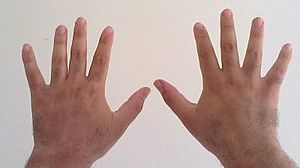Decimal facts for kids
The decimal system is the most common way we write numbers every day. It uses ten as its main base, which is why it's also called the base ten or denary system. The word "decimal" can also mean the dot (".") we use to separate whole numbers from parts of numbers, like in 3.14. This dot is called a decimal separator in many English-speaking countries.
Contents
How We Write Numbers (Decimal Notation)
Decimal notation is how we write numbers using the base-ten system. This system uses ten different symbols, called digits: 0, 1, 2, 3, 4, 5, 6, 7, 8, and 9. With these ten digits, we can write any number, no matter how big!
We often use a decimal separator (like "." or ",") to show where the whole number part ends and the fractional part begins. For example, in 2.5, the "2" is the whole number, and the "5" is the fractional part. We also use "+" for positive numbers and "−" for negative numbers.
Did you know that only two ancient systems truly used a positional decimal system (where the position of a digit changes its value)? These were the Chinese counting rods system and the Hindu-Arabic numeral system. Other systems, like the Babylonian base-60 system, needed many more symbols.
Decimals for Fractions
Any rational number (a number that can be written as a simple fraction) can be shown as a unique decimal. Sometimes, these decimals go on forever with a pattern, which we call recurring decimals.
The number ten is special because it's made by multiplying the first and third prime numbers (2 x 5 = 10). This helps make many simple decimal fractions:
- 1/2 = 0.5
- 1/3 = 0.333333... (the 3 repeats forever)
- 1/4 = 0.25
- 1/5 = 0.2
- 1/6 = 0.166666... (the 6 repeats forever)
- 1/7 = 0.142857... (the 142857 repeats forever)
- 1/8 = 0.125
- 1/9 = 0.111111... (the 1 repeats forever)
- 1/10 = 0.1
- 1/11 = 0.090909... (the 09 repeats forever)
- 1/12 = 0.083333... (the 3 repeats forever)
- 5/10 = 0.5
- 1/81 = 0.012345679012... (the 012345679 repeats forever)
History of the Decimal System
The idea of using a base-ten system has a long history, developing over thousands of years in different parts of the world.
- Ancient Times (around 3500–2500 BC): The Elamites in Iran might have used early forms of a decimal system.
- Ancient Egypt (around 2900 BC): Egyptian hieroglyphs show numbers counted in powers of 10.
- Indus Valley Civilization (around 2600 BC): This ancient civilization used decimal fractions in their weight system (like 1/20, 1/10, 1/5, 1/2).
- Ancient China (around 1400 BC): Chinese writers showed they understood the concept of decimal numbers.
- Ancient India (around 1200 BC): The Yajur-Veda text mentioned powers of 10, up to 1055.
- Later Developments:
* Around 400 BC, Pingala in India developed a binary system that connected to base-10. * Around 250 BC, Archimedes wrote Sand Reckoner, showing how to calculate with very large numbers using a decimal approach. * The Satkhandagama (100–200 AD) in India showed the earliest use of decimal logarithms. * Aryabhata (476–550 AD) used a number system that included zero. * Brahmagupta (598–670 AD) explained the Hindu-Arabic numeral system, which is the modern number system we use today, including decimal integers, negative integers, and zero. * Muḥammad ibn Mūsā al-Ḵwārizmī (780–850 AD) helped spread this system outside India. * Abu'l Hasan Ahmad ibn Ibrahim Al-Uqlidisi (920–980 AD) wrote about decimal fractions directly. * Later, the Kerala School in South India (1300–1500 AD) worked with decimal floating point numbers. * Important figures like Simon Stevin (1548/49–1620) and John Napier (1550–1617) further developed decimal concepts and logarithms.
Decimal System in Languages
Some languages use a very direct decimal system. For example, in Chinese languages (except Wu) and Vietnamese, 11 is said as "ten-one," and 23 is "two-ten-three." Japanese, Korean, and Thai have adopted this Chinese decimal system. Many other languages have special words for numbers like "eleven" or "twenty."
Incan languages like Quechua and Aymara also have a very straightforward decimal system. They might say "ten with one" for 11 and "two-ten with three" for 23.
Some experts believe that if a language has irregular ways of saying numbers, it might make it a little harder for children to learn to count.
Related pages
Images for kids
-
Diagram of the world's earliest known multiplication table (around 305 BCE) from the Warring States period in China.
-
The world's earliest decimal multiplication table was made from bamboo slips, dating from 305 BCE, during the Warring States period in China.
See also
 In Spanish: Sistema de numeración decimal para niños
In Spanish: Sistema de numeración decimal para niños





